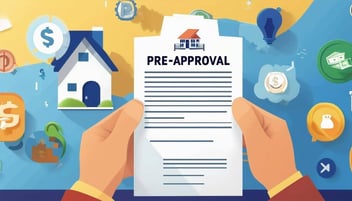18 min read

When buying a home, a proof of funds (POF) letter shows sellers and lenders that you have enough liquid assets to cover your down payment and closing costs.
It’s an official document from your bank verifying your available balance, and it can make the difference between winning or losing a home offer.
Why It Matters
-
Lenders use it to confirm financial stability and verify the source of your funds.
-
Sellers view it as proof that you’re serious and financially ready.
-
It’s often required alongside a mortgage preapproval letter.
What Qualifies as Proof of Funds:
-
Checking or savings account balances
-
Money market funds, CDs, or investment accounts
-
Cash value from certain life insurance policies
Funds must be liquid (readily available) and seasoned usually in your account for at least 60 days.
How to Get It:
-
Request it from your bank or investment firm.
-
Include your name, account type, current balance, date, and bank contact info.
-
Make sure it’s on official letterhead and signed by an authorized bank representative.
Tips for Buyers:
-
Keep your letter recent (within 30–60 days).
-
Redact account numbers for security.
-
Have both your preapproval and proof of funds ready before making offers.
Bottom Line:
A proof of funds letter is your financial first impression.
It reassures sellers that you can afford what you’re offering, and helps you close on your dream home faster.
You’ve found your dream home and you’re ready to make an offer, but there’s one key document standing between you and homeownership: a proof of funds letter. Whether you’re a first-time homebuyer or an experienced real estate investor, understanding how to prepare this financial documentation properly can make the difference between an accepted offer and a missed opportunity.
For many homebuyers, especially self-employed individuals, verifying your financial readiness isn’t just a formality, it’s essential that can strengthen your position against other prospective buyers. By the end of this guide, you’ll know exactly how to prepare a proof of funds letter for your mortgage application, ensuring you present your financial situation in the best possible light.
What is a Proof of Funds Letter?

A proof of funds letter (POF letter) is an official letter from a bank or financial institution that verifies the amount of money you have available. This formal letter should be on the bank’s official stationery, complete with the bank's contact information and official details from the bank's stationery that sellers and lenders can verify.
Unlike a bank statement that simply shows your account activity, a proof of funds document is specifically designed to validate your financial capability to complete a real estate transaction. For homebuyers, this verification shows you’re not just window shopping, you’ve got the cash to back up your offer.
Why Lenders Want a Proof of Funds Letter
Mortgage lenders require a POF letter for several reasons:

-
Risk assessment: Lenders need to verify you have enough funds to cover the down payment and closing costs before approving your loan. Buyers need to provide proof, such as a proof of funds letter or bank statements, to show sellers they have enough money to cover the costs associated with purchasing a home.
-
Financial stability: Your available funds demonstrate your ability to handle the financial responsibilities of homeownership.
-
Commitment verification: Having liquid assets shows you’re serious about the purchase and have prepared financially.
-
Regulatory compliance: Lenders must verify the source of your funds to comply with financial regulations.
In short, your POF letter assures lenders you're financially solid, confirming you have funds ready and won't withdraw unexpectedly.
What Types of Funds Qualify?
Not all assets are created equal when it comes to proving your financial readiness. Here’s what typically qualifies:
Acceptable Liquid Funds:
![]() Cash in checking or savings accounts
Cash in checking or savings accounts
![]() Money market accounts
Money market accounts
![]() Certificates of deposit (CDs)
Certificates of deposit (CDs)
![]() Stocks, bonds, and mutual funds that can be quickly liquidated
Stocks, bonds, and mutual funds that can be quickly liquidated
![]() Cash value of some life insurance policies
Cash value of some life insurance policies
Funds That May Not Qualify:
![]() Retirement accounts (401(k), IRA, etc.), unless already liquidated
Retirement accounts (401(k), IRA, etc.), unless already liquidated
![]() Home equity in another property
Home equity in another property
![]() Funds from any type of loans, including personal loans or credit card advances
Funds from any type of loans, including personal loans or credit card advances
![]() Money from a pending sale of assets
Money from a pending sale of assets
![]() Funds in foreign accounts without proper documentation
Funds in foreign accounts without proper documentation
The key requirement is that your funds must be liquid, meaning they can be easily converted into cash within a short timeframe. Most lenders prefer to see “seasoned funds” that have been in your account for at least 60 days, which proves they’re actually yours and not just borrowed temporarily to impress the lender.
Pro tip: Consolidating your funds into one bank account and using AI tools to track everything before requesting your POF letter can make the whole process cleaner and more impressive to sellers. This consolidation ensures that all necessary funds are in one place, reducing the chances of complications during the buying process.
Preapproval Letter vs. Proof of Funds Letter
It’s important to understand the distinction between these two documents:
| Aspect | Proof of Funds Letter | Preapproval Letter |
|---|---|---|
| Issued By | Your bank | Mortgage lender |
| Purpose | Verify available cash | Confirm borrowing capability |
| Basis of Verification | Current account balances | Credit history and income |
| Demonstrates | Ability to cover down payment | Ability to secure financing |
| Typical Validity | 30-60 days | 60-90 days |
While a mortgage preapproval letter shows you’re qualified for financing, a proof of funds letter verifies you have the liquid funds needed for the down payment and closing costs.
In today’s competitive market, you’ll need both documents to make a strong offer on a home: the preapproval letter shows you can get the loan, while the proof of funds letter shows you can cover the upfront costs. Having both a preapproval letter and a proof of funds letter before starting the home search assures sellers of your financial readiness and streamlines the purchasing process.
How to Get a Proof of Funds Letter
Obtaining a proof of funds letter is relatively straightforward but requires some preparation:
-
-
Contact Your Financial Institution: Reach out to your bank, credit union, or investment firm where your funds are held.
-
Request the Letter: Clearly request a "proof of funds letter" for a home purchase. Visiting a local branch in person can sometimes speed up the process.
-
Provide Necessary Information: Be ready to share:
- Property address (if available)
- Amount of funds you need to verify
- Timeline for receiving the letter
-
Undergo Verification: Your financial institution will review your accounts to confirm your available balance.
-
Receive the Letter: Most banks provide the letter electronically or through postal mail on official letterhead.
-
Most financial institutions offer this as a free service to account holders, though some may charge a nominal fee. Processing times vary while some local bank branches can provide a letter immediately, others might take 2-3 business days. Don’t wait until you’ve found the perfect house, get your letter before you start making offers.
What to Include in a Proof of Funds Letter
A proof of funds letter should include the following elements:
![]() Bank or financial institution letterhead with contact information
Bank or financial institution letterhead with contact information
![]() Date of issuance
Date of issuance
![]() Account holder’s name and physical address
Account holder’s name and physical address
![]() Account number(s) (often partially redacted for security)
Account number(s) (often partially redacted for security)
![]() Account type (checking, savings, investment, etc.)
Account type (checking, savings, investment, etc.)
![]() Current balance or exact amount of available funds
Current balance or exact amount of available funds
![]() Statement of good standing with the financial institution
Statement of good standing with the financial institution
![]() Signature from an authorized bank employee with their title
Signature from an authorized bank employee with their title
![]() Contact information for verification purposes
Contact information for verification purposes
For multiple accounts, the letter should clearly list each account separately with its corresponding balance, followed by the total funds available.
Here’s a simple template you can reference: https://formspal.com/pdf-forms/other/proof-of-funds-letter-sample/proof-of-funds-letter-sample-preview.webp
Providing more context in the proof of funds letter, such as the purpose of the funds and additional verification details, can enhance the verification process and satisfy the seller's requirements.
Making a Cash Offer with a Proof of Funds Letter
When making a cash offer on a property, your proof of funds letter becomes even more critical as it represents your entire purchasing power. In competitive markets, a strong cash offer backed by solid proof of funds can give you a significant advantage over financed offers.
A certified financial statement is one among various acceptable forms of verification that demonstrate financial capability to complete the transaction.
For cash purchases, sellers and their agents will scrutinize your proof of funds more carefully, so ensure your letter:
-
Shows at least 100% of the offer amount (plus estimated closing costs)
-
Comes from a reputable financial institution
-
Is recently dated (ideally within the last 30 days)
-
Clearly states the funds are immediately available
While some sellers might accept recent bank statements instead, nothing beats an official letter on bank letterhead—it just looks more legitimate and serious.
How to Keep Your Proof of Funds Letter Secure?
Your proof of funds letter contains sensitive information that needs protection:

-
Redact account numbers: Request that your bank show only the last 4 digits of account numbers.
-
Limit distribution: Share only with your real estate agent, the seller's agent, and your mortgage lender.
-
Use secure delivery: Send electronic copies via encrypted email or secure document sharing.
-
Track copies: Keep a record of who has received your financial documentation.
-
Update regularly: Destroy outdated versions when you obtain updated letters.
Remember that legitimate parties in a real estate transaction have no need to see your full account numbers or routing information. If anyone requests unredacted financial information, consult with your real estate agent or attorney before providing it.
How Long is a Proof of Funds Letter Valid?
The validity period of a proof of funds letter varies by lender and situation. While these letters do not have a hard expiration date, their usefulness diminishes over time. Some lenders and sellers may accept a letter dated within the last 60 days, while others may require documentation no older than 30 days.
To ensure your proof of funds letter remains current:
![]() Ask your lender about their specific requirements for document recency
Ask your lender about their specific requirements for document recency
![]() Request an updated letter before making an offer if your existing one is more than 30 days old
Request an updated letter before making an offer if your existing one is more than 30 days old
![]() Maintain consistent balances in your accounts during the home buying process
Maintain consistent balances in your accounts during the home buying process
![]() Alert your bank if you’ll need multiple letters over time
Alert your bank if you’ll need multiple letters over time
If your house hunt drags on, ask your bank if they can set up a standing authorization to provide updated letters quickly when needed. Buyers must show they can cover the full cost of a home, either through liquid assets or cash, to assure sellers and lenders of their ability to complete the purchase.
Other Documents You May Need
While a proof of funds letter is essential, you may need additional financial documentation to support your mortgage application:
-
Recent bank statements: Usually the last 2-3 months of statements to verify consistent fund availability
-
Investment account statements: To verify additional assets
-
Gift letters: If any portion of your down payment comes from family gifts
-
Proof of deposit letter: Specifically verifying funds earmarked for the down payment
-
Source of funds documentation: Explaining large deposits or fund transfers
-
Pay stubs and tax returns: To verify income, especially for self-employed individuals
Think of these documents as your financial resume: the more organized and complete your paperwork, the more seriously sellers and lenders will take you.
Using a Proof of Funds Letter to Cover Down Payment

Your proof of funds letter plays a vital role in demonstrating your ability to cover the down payment, often the largest upfront expense in a home purchase. Here’s how to ensure your letter effectively addresses this requirement:
-
Calculate the exact amount needed for your down payment (typically 3-20% of the purchase price)
-
Add estimated closing costs (typically 2-5% of the purchase price, though this varies significantly by location, loan type, and transaction complexity)
-
Include a buffer of at least 1-2% for unexpected expenses
-
Ensure your letter shows at least this total amount in available funds
For example, on a $400,000 home with a 20% down payment ($80,000) and estimated closing costs of $8,000, your proof of funds letter should show at least $88,000 in available funds—ideally more to demonstrate financial stability beyond the minimum requirements.
Most sellers and lenders want to see that you’ll have financial reserves remaining after covering these purchase costs, so having additional funds can strengthen your position significantly. Consolidating necessary funds into one bank account can streamline the purchasing process and ensure all funds are readily available for transaction purposes.
Finalizing Your Proof of Funds Document
Before submitting your proof of funds letter, take these final steps to ensure it’s effective:

-
Verify accuracy: Check all names, account numbers, and balances for errors.
-
Confirm recency: Ensure the letter is dated within the acceptable timeframe for your lender.
-
Make copies: Keep digital and physical copies for your records.
-
Secure sensitive information: Store copies securely to protect your financial information.
-
Prepare to explain: Be ready to answer questions about the source and history of your funds.
-
Verify all financial documents: Ensure that all financial documents, including the preapproval letter and proof of deposit, are accurate and up-to-date.
Remember that your proof of funds letter is often your financial first impression. A well-prepared, comprehensive letter demonstrates your attention to detail and financial responsibility—qualities that both sellers and lenders value highly in potential homebuyers. Proof of funds letters should verify not just funds in checking or savings accounts, but also in investment accounts and other assets.
Frequently Asked Questions About Proof of Funds Letters
What's the difference between a proof of funds letter and a bank statement?
A proof of funds letter is an official document issued by your financial institution that verifies your available funds on letterhead with an authorized signature. Bank statements show your account activity and balance but lack the formal verification that most sellers and lenders require for real estate transactions. An official bank statement is the most common form of proof of funds, as it provides a direct verification of the buyer's available liquid funds.
What's the difference between a proof of funds letter and a bank statement?
A proof of funds letter is an official document from your financial institution verifying your available funds on bank letterhead with an authorized signature. A bank statement shows your account balance and transactions but lacks the formal verification sellers and lenders typically require.
Can I use funds from multiple accounts for my proof of funds letter?
Yes, you can combine funds from multiple accounts or institutions. Clearly list each account balance and provide a total amount available. However, consolidating funds into one account simplifies the process and creates a clearer, more persuasive document for sellers and lenders.
Do I need a proof of funds letter if I'm already preapproved for a mortgage?
Absolutely. A preapproval indicates how much you can borrow, but a proof of funds letter demonstrates you have cash available for upfront costs like the down payment and closing expenses. Having both documents ready signals to sellers that you're financially prepared and serious, boosting your credibility in competitive markets.
What happens if my available funds change after I receive my proof of funds letter?
If your balances significantly decrease, request an updated letter immediately. Outdated financial documentation can derail your purchase, especially during final underwriting. Conversely, increased balances can strengthen your buying position, so always keep your documentation current.
Can I get a proof of funds letter online?
Many major banks, including Chase, Bank of America, and Wells Fargo, provide proof of funds letters online, often with same-day delivery. Smaller banks or credit unions might require a call or branch visit. Contact your bank directly to explore their online options for quicker processing.
Are there fees associated with obtaining a proof of funds letter?
Most banks offer proof of funds letters free, although some charge a small fee (usually $10-25). Investment firms like Fidelity or Vanguard often charge for this service. Always confirm potential fees upfront, but consider any small charge a worthwhile investment to strengthen your offer and demonstrate financial readiness to sellers.
Conclusion
Preparing a clear, accurate proof of funds letter is essential to your home-buying success. It reassures lenders and sellers that you're financially capable, organized, and serious, giving you a distinct edge in today's competitive market. Whether you're buying with cash or securing a mortgage, this document is your financial first impression, make it count.
Don't let your dream home slip away because your paperwork was delayed. Contact your bank today to request your proof of funds letter. Being proactive now ensures you’re ready to confidently seize opportunities the moment they arise.
Table of Content

Take your pick of loans
Experience a clear, stress-free loan process with personalized service and expert guidance.
Get a quote


